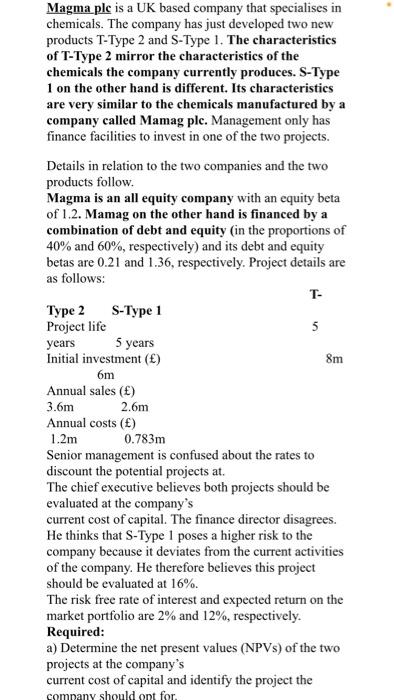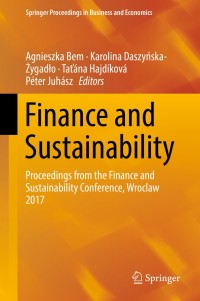I NEED AN IMMEDIATE ANSWER TO ALL PARTS OF THIS QUESTION PLEASE

Magma ple is a UK based company that specialises in chemicals. The company has just developed two new products T-Type 2 and S-Type 1. The characteristics of T-Type 2 mirror the characteristics of the chemicals the company currently produces. S-Type 1 on the other hand is different. Its characteristics are very similar to the chemicals manufactured by a company called Mamag plc. Management only has finance facilities to invest in one of the two projects. Details in relation to the two companies and the two products follow. Magma is an all equity company with an equity beta of 1.2. Mamag on the other hand is financed by a combination of debt and equity (in the proportions of 40% and 60%, respectively) and its debt and equity betas are 0.21 and 1.36, respectively. Project details are as follows: T- Type 2 S-Type 1 Project life 5 years Initial investment () 5 years 8m 6m Annual sales () 3.6m 2.6m Annual costs () 1.2m 0.783m Senior management is confused about the rates to discount the potential projects at. The chief executive believes both projects should be evaluated at the company's current cost of capital. The finance director disagrees. He thinks that S-Type 1 poses a higher risk to the company because it deviates from the current activities of the company. He therefore believes this project should be evaluated at 16%. The risk free rate of interest and expected return on the market portfolio are 2% and 12%, respectively. Required: a) Determine the net present values (NPV) of the two projects at the company's current cost of capital and identify the project the company should ont for T- Type 2 S-Type 1 Project life 5 years 5 years Initial investment () 8m m Annual sales (5) 3.6m 2.6m Annual costs () 1.2m 0.783m Senior management is confused about the rates to discount the potential projects at. The chief executive believes both projects should be evaluated at the company's current cost of capital. The finance director disagrees. He thinks that S-Type 1 poses a higher risk to the company because it deviates from the current activities of the company. He therefore believes this project should be evaluated at 16%. The risk free rate of interest and expected return on the market portfolio are 2% and 12%, respectively. Required: a) Determine the net present values (NPVs) of the two projects at the company's current cost of capital and identify the project the company should opt for. (7 marks) b) Re-compute the NPV of the S-Type 1 project at 16% as suggested by the finance director. Comparing the NPVs of the two projects, identify the project the company should opt for. (3 marks) c) Comment on the views of the chief executive and the finance director. (5 marks) d) Re-compute the NPV of the S-Type I project at the rate you deem suitable and comparing the NPVs of the two projects, identify the project the company should opt for. (5 marks) (Total 20 marks) Magma ple is a UK based company that specialises in chemicals. The company has just developed two new products T-Type 2 and S-Type 1. The characteristics of T-Type 2 mirror the characteristics of the chemicals the company currently produces. S-Type 1 on the other hand is different. Its characteristics are very similar to the chemicals manufactured by a company called Mamag plc. Management only has finance facilities to invest in one of the two projects. Details in relation to the two companies and the two products follow. Magma is an all equity company with an equity beta of 1.2. Mamag on the other hand is financed by a combination of debt and equity (in the proportions of 40% and 60%, respectively) and its debt and equity betas are 0.21 and 1.36, respectively. Project details are as follows: T- Type 2 S-Type 1 Project life 5 years Initial investment () 5 years 8m 6m Annual sales () 3.6m 2.6m Annual costs () 1.2m 0.783m Senior management is confused about the rates to discount the potential projects at. The chief executive believes both projects should be evaluated at the company's current cost of capital. The finance director disagrees. He thinks that S-Type 1 poses a higher risk to the company because it deviates from the current activities of the company. He therefore believes this project should be evaluated at 16%. The risk free rate of interest and expected return on the market portfolio are 2% and 12%, respectively. Required: a) Determine the net present values (NPV) of the two projects at the company's current cost of capital and identify the project the company should ont for T- Type 2 S-Type 1 Project life 5 years 5 years Initial investment () 8m m Annual sales (5) 3.6m 2.6m Annual costs () 1.2m 0.783m Senior management is confused about the rates to discount the potential projects at. The chief executive believes both projects should be evaluated at the company's current cost of capital. The finance director disagrees. He thinks that S-Type 1 poses a higher risk to the company because it deviates from the current activities of the company. He therefore believes this project should be evaluated at 16%. The risk free rate of interest and expected return on the market portfolio are 2% and 12%, respectively. Required: a) Determine the net present values (NPVs) of the two projects at the company's current cost of capital and identify the project the company should opt for. (7 marks) b) Re-compute the NPV of the S-Type 1 project at 16% as suggested by the finance director. Comparing the NPVs of the two projects, identify the project the company should opt for. (3 marks) c) Comment on the views of the chief executive and the finance director. (5 marks) d) Re-compute the NPV of the S-Type I project at the rate you deem suitable and comparing the NPVs of the two projects, identify the project the company should opt for. (5 marks) (Total 20 marks)









